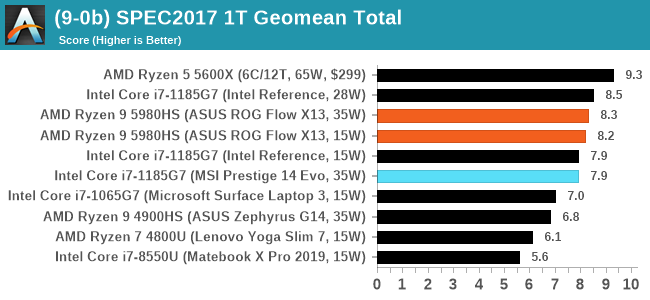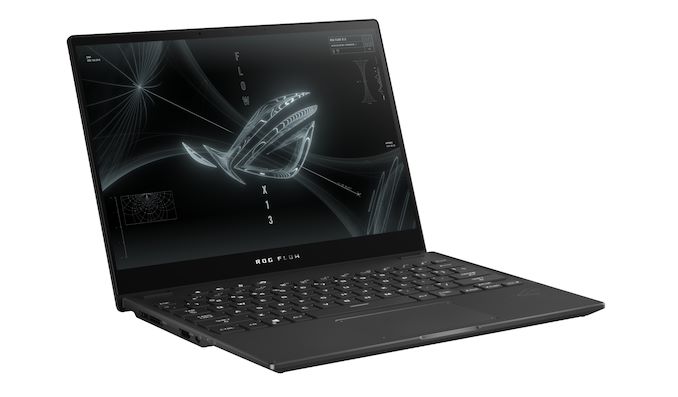AMD Ryzen 9 5980HS Cezanne Review: Ryzen 5000 Mobile Tested
by Dr. Ian Cutress on January 26, 2021 9:00 AM EST- Posted in
- CPUs
- AMD
- Vega
- Ryzen
- Zen 3
- Renoir
- Notebook
- Ryzen 9 5980HS
- Ryzen 5000 Mobile
- Cezanne
Focusing on Premium Experiences
The issue with AMD’s notebook strategy through the 2010s was that most users saw the brand as a budget implementation, with low performance and low specifications. Both AMD and its OEM partners were complicit in assisting this projection, using 1366x768 TN screens and slow mechanical hard drives. There were a number of negative feedback loops preventing a nice AMD mobile system from hitting the market, and the only key design wins were from mass corporate sales. With the launch of the first Ryzen Mobile towards the end of the decade, AMD finally had a performance product worthy of attention, and the company has had a steady improvement generation-on-generation, convincing its OEM partners to come along and take advantage of the performance uplift for their customers.
AMD’s historic lows in that 2010 decade were performance, specifications, and battery life. With Ryzen 4000 Mobile, from last generation, AMD had a product that could dispel all those assumptions, and we saw critical acclaim put upon devices like the Lenovo Slim 7 Yoga, and the ASUS Zephyrus G14. From our review of the new generation today, Ryzen 5000 Mobile, the whole strategy that AMD is playing has finally come into focus.
AMD stated that the new generation Ryzen 5000 Mobile processors were in the lab and up-and-running only two months after Ryzen 4000 Mobile launched. AMD made both sets of processors pin-compatible, allowing OEM partners to build designs that could be used for either processor family. The key here that I’ve realized is that AMD’s ultimate goal with these was to build a strong Ryzen 5000 Mobile family, and Ryzen 4000 Mobile was an option for partners to take baby steps, but the main goal was Ryzen 5000, with Zen 3. AMD’s statement of already having over 150+ system designs in the works with Ryzen 5000 Mobile, another +50% over the previous generation, along with this strategy of having a regular predictable cadence of products through re-use of different hardware elements showcases why Ryzen 5000 Mobile is important to the company. With AMD’s recent supply issues as well, we’re of the opinion that AMD has been stockpiling these Ryzen 5000 Mobile processors in order to enable a strong Q1 and Q2 launch of the platform with stock for all OEMs.
What we tested today is one of the AMD flagships for launch, the Ryzen 9 5980HS inside the ASUS ROG Flow X13. This is a sub-16mm ultraportable gaming laptop with a mid-range discrete GPU installed, an impressive 4K 16:10 Pantone certified IPS display, 32GB LPDDR4X memory and a 1 TB NVMe SSD. It also has an executive feel and design, indicating that both AMD and ASUS want to take this platform to its most premium customers. We’re leaving a full review of the laptop itself for a later date, let us focus on the performance of the processor inside.
The jump from Zen 2 to Zen 3 in the mobile space for AMD is more than just putting in the new cores. The cache adjustment from a split 4+4 MB L3 cache to a unified 16 MB L3 cache enables a better effective latency and less reliance on constantly going out to main memory – AMD is also aggressive on the L3 prefetching policies to drive performance. We can see that the single 8-core CCX has low core-to-core communication latency showcasing that enthusiast level workloads will benefit in more ways than one.
AMD is also piling on improvements to help with power, such as enabling different per-core voltage levels and a more efficient memory controller. Per-core voltage control is something that every modern CPU has to have (or at least islands of CPUs) in order to get the best battery performance. AMD is pairing this with its CPPC2 support, and users will benefit from very quick idle-to-turbo performance for immediate responsiveness.

For our benchmark suite, almost all of our benchmarks show an uplift for the new Ryzen 5000 Mobile series, some considerably so: our compile benchmark is +12%, Corona rendering is +18%, Dolphin emulation +17%, NAMD +8%, Blender +6%. To our surprise our SPEC2006 1T benchmark is +32%, accelerated considerably by the 16 MB L3 cache, but also because these CPUs also support a higher instantaneous power turbo modes than the previous generation. This enables some competitive performance numbers against Intel’s Tiger Lake platform in single thread focused tests (AMD wins on multithread quite easily).
All of these core updates, as well as design wins enabling better hardware under the hood, put AMD’s Ryzen 5000 Mobile series in good stead to power a generation of machines especially as more and more of us work from home. When Intel was in a period of high demand through 2018 and 2019, Intel focused on premium solutions to make the most revenue - Intel’s financials last week showed that the company was selling more and more education-focused low-end notebooks and Chromebooks, now that demand had reduced. We can apply something similar to AMD's current situtation - AMD’s silicon is in high demand for 2021, and so AMD’s target this year would appear to be more mid-range, premium commercial, and enthusiast machines. To reaffirm this, AMD has also promised that we will see notebooks this year paired with the most powerful mobile graphics cards, enabling high-performance gamers to move to AMD. No doubt we will have a number pass through our hands through the year, especially as they hit the shelves starting February.












218 Comments
View All Comments
Lemnisc8 - Tuesday, January 26, 2021 - link
Can someone PLEASE find out if this thing is running in quad channel or dual channel lpddr4x. It’s already at a disadvantage since lpddr4x has half the bus width of standard ddr4. It would be fine if it ran in quad channel because it’s bus width would then be the same size as ddr4 at 128 bits, but no reviews anywhere show what channel configuration it’s running in...neblogai - Tuesday, January 26, 2021 - link
I don't think there were any 4000-series laptops running LPDDR4x just dual channel- I've only seen it to be quad-channel. So this flagship device (and used by AMD to impress about 5000H performance) should be no different.xza23 - Tuesday, January 26, 2021 - link
As always , excellent article , thank you!watzupken - Tuesday, January 26, 2021 - link
I feel with the introduction of Renoir, what blew most away is the fact that AMD managed to squeeze 8 cores into the U series. Not only that, the Zen 2 architecture also resulted a some serious uplift in performance as compared to the previous Zen+. This year round while it is all nice and good to see decent performance bump, the wow factor is not there. I am not expecting a core increase especially on the same N7 node, and to be honest, 8 cores is plenty of performance for a mobile PC.On the point of still using Vega, despite the age, Vega is still very competitive. One may argue that Intel's Xe graphics is better, but reviews out there proved otherwise. Xe is certainly fast, but both the iGPUs from AMD and Intel are likely memory bandwidith limited if one is pushing 1080p. Adding more cores will likely have diminishing returns. And honestly if you are a gamer, you cannot avoid getting a system with a dedicated GPU no matter how good the iGPU is.
Fulljack - Wednesday, January 27, 2021 - link
I agree, the R&D cost of moving from Vega to RDNA probably isn't worth it in the grand scheme of business.rumor has it that in 2022, Rembrandt will still leverage Zen 3 CPU but will use RDNA2 with DDR5 memory.
Ptosio - Wednesday, January 27, 2021 - link
Shouldn't it be pretty straightforward given that these APU already kind-of exist in the consoles?Hopefully Alder Lake would push AMD to offer best CPU/GPU combination they have!
As I understand, going to RDNA2 would also mean smaller core for the same performance? So there should be some savings in it for AMD as well.
Spunjji - Thursday, January 28, 2021 - link
"Shouldn't it be pretty straightforward given that these APU already kind-of exist in the consoles?"Those APUs use a totally different memory subsystem, much larger GPU slices, and they also use Zen 2 cores. AMD were specifically aiming to get Zen 3 out across their range - there's probably a lot of work needed to scale RDNA 2 down to iGPU levels without unbalancing its performance.
zamroni - Tuesday, January 26, 2021 - link
Amd should reduce Cezanne's core count to 6 then use the transistor budget for more gpu cores.That way it will beat all Intel laptop processors at all aspects
dicobalt - Tuesday, January 26, 2021 - link
Now they need to sell a version that cuts out the silly integrated graphics and uses a faster dedicated GPU. I don't understand the motivation for having a steroid pumped 8 core CPU paired with anemic integrated graphics. It seems AMD is more interested in selling the idea of APUs than actually providing a balanced system.Zizy - Wednesday, January 27, 2021 - link
AMD is clear that integrated GPU is for the very same chip at 15W. It is a pretty fine GPU there, TDP and bandwidth limit potential anyway. I wonder what is the die area saving by ditching GPU. If it is sizeable then yeah, it would be great to have a GPU-less variant of the chip, especially with current wafer supply issues.